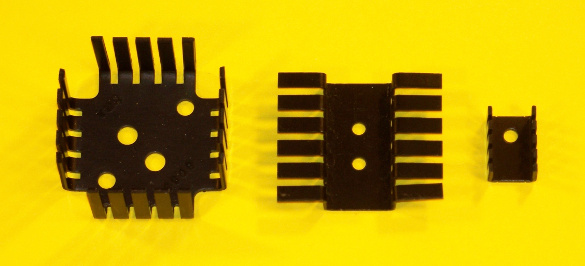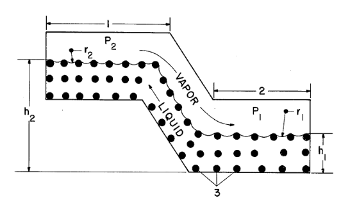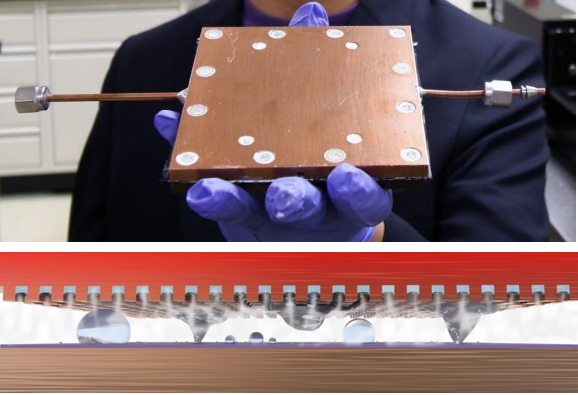Heat Sinks
October 12, 2020
Physicists are accustomed to
mysterious and
miraculous phenomena.
Quantum mechanics is a prime example with its "
spooky action at a distance," but there are also
cosmic phenomena such as
black holes. Each of these are quite removed from
everyday life, the former happening for things too small to see, and the later at unreachable distances, but there is an amazing phenomenon that occurs for objects that you can hold in your
hands. It's so amazing that it deserved a mention in the
venerable Feynman Lectures on Physics.[1]
This phenomenon occurs for the
metrology objects called
gauge blocks.
Machinists call these "Jo" blocks in honor of their
inventor,
Carl Edvard Johansson (1864–1943). These are finely-
polished metal or
ceramic blocks that have the property that they
stick together without
adhesive because of
interatomic forces. As
Nobel Physics Laureate,
Richard Feynman (1918-1988), wrote about this phenomenon for
copper in section 12–2 (
Friction) in The Feynman Lectures,
The reason for this unexpected behavior is that when the atoms in contact are all of the same kind, there is no way for the atoms to "know" that they are in different pieces of copper."
In creating gauge blocks, Johansson employed the
kitchen development method also used by
American physicist,
Chester Carlson, about whom I wrote in an
earlier article (Larry Tesler (1945-2020), March 30, 2020). Carlson started his
experiments that led to the invention of
Xerography in his
apartment kitchen. He was eventually forced to find a different location for his
laboratory after
complaints by his
wife of too many bad
odors,
fires, and
explosions. Johansson's experiments were more benign, although he did convert his wife's
sewing machine into a
lapping machine, and he enlisted his wife's help in
polishing and
grinding. The concept of gauge blocks has been extended to a
joining technique called
cold welding used mostly in
nanofabrication.

Fig. 10 from Chester Carlson's October 6, 1942, Xerography patent, "electrophotography," US Patent No. 2,297,691.[2].
Carlson discovered that an electrostatically-charged zinc plate, coated with sulfur, could form an image he could transfer to paper.
The rotten egg smell of hydrogen sulfide is one of the things that prompted his wife's request that he relocate his laboratory. (Via Google Patents.[2])
Since
transistors and their
integrated circuits are not 100%
efficient,
computers generate a lot of
waste heat. The conventional technique for removal of waste heat is to attach a
heat sink. While these can be a large
thermal reservoir, like a large block of a
thermally conductive material such as
aluminum or
copper, the usual heat sink is a
finned structure in contact with the
electronic package to
transport heat to an
air flow (see figure). For heat sinks to be effective, there must be close contact between the heat sink and what's being cooled.

Power transistor heat sinks. The heat sink on the left is for a TO-3 case; the one at the center is for two TO-220 transistors, as in an NPN/PNP complementary pair; and the one on the right is a small heat sink for a circuit board mounted TO-220, such as a voltage regulator. The most common material for heat sinks are members of the 6000 series aluminum alloys, which have thermal conductivity from about 165 - 201 W/m-K. Photo by the author, also available at Wikimedia Commons
Since close contact between circuitry and their heat sinks is unlike like that of gauge blocks, the usual tactic is application of a
thermal paste that transports heat across the
interface. Thermal paste typically contains a
filler of about 75% of thermally conductive materials such as
boron nitride,
zinc oxide,
aluminum oxide, and
aluminum nitride in a
silicone matrix, although other
organic matrix materials are used.
Decades ago, highly thermally conductive
beryllium oxide was used as a filler, but it is not now being used because of its
toxicity. Beryllium oxide is
electrically insulating, and it has the highest thermal conductivity (330 W/m-K) of non-metals except for
diamond.
When space is too constricted for the air flow needed for heat removal,
heat pipes are often used to transport heat away from the electronics to cooler regions. A heat pipe extracts heat at a hot spot by
vaporizing a
liquid. This
vapor is then
condensed at a cooler region, and the liquid is transported back to the hot region by
capillary action. In most electronics cooling applications, the liquid is
methanol (
Boiling point, 64.7°C) or
ethanol (Boiling point, 78.2°C).
While the general concepts for a heat pipes were known for many decades, It was George Grover of
Los Alamos National Laboratory who
patented a capillary heat pipe in 1963.[3] This patent was the first to use the term,
heat pipe, and heat pipes became especially important for
thermal management of
satellites and
spacecraft. As Grover's patent states, "Accordingly, the invention is a heat transfer device comprising a
container, said container enclosing a condensable vapor and capillary means within the container capable of causing the transport of the condensed vapor from a cooler area of the container to a hotter area."[3]

Fig. 1 from US Patent No. 3,229,759. "Evaporation-condensation heat transfer device," by George M Grover, January 18, 1966.
The dots, shown as item 3, are a wire mesh capillary fabric.
(Via Google Patents.[3])
Of course, the best method of thermal management of electronics is to make more efficient circuitry. The next level
supercomputer, as implemented using
1970s technology, was envisioned as a "
hairy,
smoking golf ball." It would have been hairy, because of all the necessary
interconnections to the outside world; golf ball sized, because of the limitation imposed by the
speed of light; and, smoking, because of all the waste heat generated. Advances in transistor technology, especially
low voltage field effect transistors, have increased efficiency tremendously, but there is still a need for better heat-sinking technologies.
Mechanical engineers at
Virginia Polytechnic Institute and State University have recently
published research on a thermal management device in the
journal,
Advanced Functional Materials.[4-5] The device is a
planar bridging-
droplet thermal diode that allows heat flow in only one direction. I wrote about thermal diodes in an earlier article (
Thermal Diodes, February 19, 2014). One thermal diode concept is based on junctions between materials with opposite
temperature coefficients of thermal conductivity,[6] and another on
phonon confinement in the lateral dimension of
graphene nanoribbons.[7-8]
This research was led by
Jonathan Boreyko, an
associate professor in
Mechanical Engineering at Virginia Tech, who says, "We are hopeful that the one-way heat transfer of our bridging-droplet diode will enable the smart thermal management of electronics,
aircraft, and
spacecraft."[5] Their bridging‐droplet thermal diode is constructed from two
parallel copper plates separated by a
micrometer-sized gap(see figure).[4-5] One plate has a
superhydrophilic wick structure holding
water, and the other is smooth and
hydrophobic.

The upper image shows an example of the Virginia Tech thermal diode, and the lower image shows an example of the operating principle. The hot plate with the superhydrophilic wick structure is shown in red. (Upper image, portion of a photo by Alex Parrish, and lower image, both from the Virginia Polytechnic Institute and State University.[5])
The water at the wick of the hot plate is heated to become
steam, which moves across the narrow gap. At the plate opposite to the gap, the steam cools and condenses.[4-5] Eventually, the droplets grow large enough to bridge the gap, and they are sucked back into the wick.[5] The large
contact angle of the condensate drops at the hydrophobic plate enables bridging across the gap to replenish the wicked evaporator.[4-5]
Diode action is achieved, since heating the hydrophobic plate just results in a dry surface and no heat transfer.[4-5] Measurements showed an orientation‐independent heat transfer
ratio of up to 85.[4] According to Boreyko, this is better performance than other thermal diodes, some of which are orientation-dependent, and all of which have a smaller ratio.[5] The Virginia Tech team has filed a
provisional patent application on this device.[5]
References:
- Richard P. Feynman, Robert B. Leighton, and Matthew Sands, "The Feynman Lectures on Physics," (First published in 1964, now in recent editions), ISBN: 978-0465023820 (via Amazon).
- Chester F. Carlson, "electrophotography," US Patent No. 2,297,691 (October, 1942).
- George M Grover, "Evaporation-condensation heat transfer device," US Patent No. 3,229,759, January 18, 1966.
- Mojtaba Edalatpour, Kevin R. Murphy, Ranit Mukherjee, and Jonathan B. Boreyko, "Bridging‐Droplet Thermal Diodes," Advanced Functional Materials, Article No. 2004451 (August 18, 2020), https://doi.org/10.1002/adfm.202004451,
- Alex Parrish, "Novel method of heat conduction could be a game changer for server farms and aircraft," Virginia Tech Press Release, August 18, 2020.
- W. Kobayashi, Y. Teraoka and I. Terasaki, "An oxide thermal rectifier," Applied Physics Letters, vol. 95, no. 17 (October, 2009), Document No. 171905 (3 pages); available, also, on arXiv.
- Yan Wang, Ajit Vallabhaneni, Jiuning Hu, Bo Qiu, Yong P. Chen and Xiulin Ruan, "Phonon Lateral Confinement Enables Thermal Rectification in Asymmetric Single-Material Nanostructures," Nano Letters, vol. 14, no. 2 (January 6, 2014), pp. 592-596, https://doi.org/10.1021/nl403773f.
- Emil Venere, "Research could bring new devices that control heat flow," Purdue University Press Release, January 27, 2014.
Linked Keywords: Physicist; mystery; mysterious; miracle; miraculous; phenomenon; phenomena; quantum mechanics; quantum entanglement; spooky action at a distance; cosmos; cosmic; black hole; everyday life; hand; venerable; The Feynman Lectures on Physics; metrology; gauge block; machinist; invention; inventor; Carl Edvard Johansson (1864–1943); polishing; polished; metal; ceramic; cuboid; block; adhesion; stick; adhesive; interatomic force; Nobel Physics Laureate; Richard Feynman (1918-1988); copper; friction; atom; kitchen; research and development; American; Chester Carlson; experiment; Xerography; apartment; laboratory; complaint; wife; odor; fire; explosion; sewing machine; lapping machine; grinding (abrasive cutting); joint; joining; cold welding; nanofabrication; patent; electric charge; electrostatically-charged; zinc; sulfur; image; paper; rotten egg smell; hydrogen sulfide; Google Patents; transistor; integrated circuit; energy conversion efficiency; efficient; computer; waste heat; heat sink; thermal reservoir; thermal conductivity; thermally conductive; material; aluminum; copper; fin; electronic package; heat transfer; transport heat; air flow; power semiconductor device; power transistor; TO-3 case; TO-220; NPN/PNP complementary pair; printed circuit board; voltage regulator; 6000 series aluminum alloy; watt; meter; kelvin; Wikimedia Commons; thermal paste; interface (matter); filler material; boron nitride; zinc oxide; aluminum oxide; aluminum nitride; silicone; composite material; matrix; organic chemistry; decade; beryllium oxide; toxicity; insulator (electrical); electrically insulating; diamond; heat pipe; vaporization; vaporizing; liquid; vapor; condensation; condense; capillary action; methanol; boiling point; ethanol; thermal management; satellite; spacecraft; container; wire mesh; textile; fabric; supercomputer; 1970s; technology; hair; hairy; smoke; smoking; golf ball; electrical connection; interconnection; speed of light; low voltage; field effect transistor; mechanical engineering; mechanical engineer; Virginia Polytechnic Institute and State University; scientific literature; publish; research; scientific journal; Advanced Functional Material; plane (geometry); planar; bridge; bridging; drop (liquid); droplet; temperature coefficient; phonon; graphene nanoribbon; Jonathan Boreyko; associate professor; Mechanical Engineering at Virginia Tech; aircraft; parallel (geometry); micrometer-sized; superhydrophilicity; superhydrophilic; wick; water; hydrophobe; hydrophobic; Virginia Tech; Alex Parrish; contact angle; ratio; provisional patent application.
-